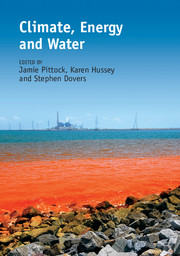Book contents
- Frontmatter
- Contents
- List of contributors
- Acknowledgements
- 1 Justifying, extending and applying “nexus” thinking in the quest for sustainable development
- 2 Water resources, climate change and energy
- 3 Implications of climate change for energy systems in a multisectoral context
- 4 Fossil fuels and water: A complex and evolving relationship
- 5 Renewable energy and water
- 6 Hydropower within the climate, energy and water nexus
- 7 Water and biofuels
- 8 Trade-offs and synergies between water and energy use in rural Australia
- 9 Management of the urban energy-water nexus
- 10 Managing the electricity-water nexus in China, France, India and the United States
- 11 Cross-sectoral governance of the climate, energy and water sectors: A ‘Rubik's cube’ analysis of cross-sectoral co-ordination
- 12 Regulation of the nexus
- 13 Climate, energy and water: the potential roles and limitations of markets
- 14 Strategies to mainstream climate change, energy, water and food security nexus knowledge and skills
- 15 A nexus of nexuses: systemic governance for climate response
- 16 Integrated modelling of the energy-water nexus in the American West
- 17 Biodiversity and the climate, energy and water nexus
- 18 Consumers, food supply chain and the nexus
- 19 Future prospects in climate, energy and water research and policy
- Index
15 - A nexus of nexuses: systemic governance for climate response
Published online by Cambridge University Press: 05 April 2015
- Frontmatter
- Contents
- List of contributors
- Acknowledgements
- 1 Justifying, extending and applying “nexus” thinking in the quest for sustainable development
- 2 Water resources, climate change and energy
- 3 Implications of climate change for energy systems in a multisectoral context
- 4 Fossil fuels and water: A complex and evolving relationship
- 5 Renewable energy and water
- 6 Hydropower within the climate, energy and water nexus
- 7 Water and biofuels
- 8 Trade-offs and synergies between water and energy use in rural Australia
- 9 Management of the urban energy-water nexus
- 10 Managing the electricity-water nexus in China, France, India and the United States
- 11 Cross-sectoral governance of the climate, energy and water sectors: A ‘Rubik's cube’ analysis of cross-sectoral co-ordination
- 12 Regulation of the nexus
- 13 Climate, energy and water: the potential roles and limitations of markets
- 14 Strategies to mainstream climate change, energy, water and food security nexus knowledge and skills
- 15 A nexus of nexuses: systemic governance for climate response
- 16 Integrated modelling of the energy-water nexus in the American West
- 17 Biodiversity and the climate, energy and water nexus
- 18 Consumers, food supply chain and the nexus
- 19 Future prospects in climate, energy and water research and policy
- Index
Summary
Introduction
It has become a feature of the governance lexicon to refer to narrowly focused, single-issue policy domains as ‘silos’. In its original context, the word refers to vertical grain storages that sit alongside each other, but are compartmentalised and largely function separately. From a governance perspective that embraces complexity and holism, the term ‘silo’ is often used pejoratively to denote approaches that can't deal with messy, real-world situations. One could extend the metaphor to the fact that most silos are filled from the top and emptied from the bottom: a reflection of the top-down nature of siloed policy domains. How is it that silos have become so entrenched in our current governance regimes? Silos could result from efforts to simplify management tasks, or from a tendency to classify and conceptually delineate our environment, or perhaps they emerge from a more fundamental nature–culture divide.
It is clear that the silo approach to governance can lead to serious unintended consequences. For example, in the well-studied case of the Kissimmee River, part of the Florida Everglades in the United States, the river and its surrounding floodplains were historically managed for the primary goal of flood control. The channel of the river was even refashioned into a canal for increased hydraulic efficiency, which severely damaged the ecological integrity of the river (Koebel 1995). A large-scale restoration program is currently being carried out to restore the floodplain and river ecosystem, which some have described as a successful transition to a more sustainable trajectory (Olsson et al. 2006). This is probably an extreme example, but it demonstrates the possible consequences of managing to one goal: in this case, flood protection. In Australia, there is a long history of separation, nowhere clearer than in water politics, where water itself has become a disembodied entity:
Australian water politics and decision-making processes are highly contested. Contemporary water politics is characterised by conceptual and bureaucratic separation of water – from land, and from social processes.
(Gibbs 2013, p. 469)- Type
- Chapter
- Information
- Climate, Energy and Water , pp. 253 - 267Publisher: Cambridge University PressPrint publication year: 2015
- 1
- Cited by



